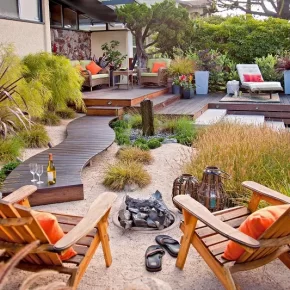A garden pond is not only a beautiful decorative element, but also a great way to bring coziness and tranquility to your garden. The sound of water, the reflection of plants and the play of light create a special atmosphere.
1. Choosing a place for a pond
Before starting, it is important to decide on a place for the future reservoir.
- Sunlight. Choose a place that gets at least 5-6 hours of sun a day. Too much shade can cause algae growth.
- Distance from trees. Falling leaves pollute the water, and tree roots can damage the pond structure.
- Landscape. Place the pond in the lower part of the plot for natural water collection, but avoid places where water can stagnate.
- Access to electricity. If you plan to install a pump or lighting, consider the proximity of the electricity source.
2. Planning and materials
The choice of materials depends on the size and type of pond.
Shape and size
- A small pond. Ideal for small gardens. You can use ready-made plastic forms.
- Medium and large pond. For larger projects, flexible waterproofing films or concrete structures are suitable.
- Natural look. Choose asymmetrical shapes that look more natural.
Materials
- Plastic forms. A simple and quick way to create a pond.
- Waterproofing film. Use a special PVC or butyl rubber film that is resistant to water and sunlight.
- Concrete. A reliable and durable option for large reservoirs.
- Decor. Stones, gravel, wood or even decorative ceramics to frame the banks.
3. The arrangement process

Step 1: Preparation
- Determine the shape and dimensions.
- Dig the hole according to the plan. Make several levels: deep for aquatic plants, shallow for decorative ones.
- Remove all sharp objects that could damage the film or mold.
Step 2: Stacking materials
- Cover the pit with a layer of sand (5-10 cm) to protect the base.
- Install a plastic form or lay a film. If using a film, secure its edges with stones.
Step 3: Filling with water
Gradually fill the pond with water so that the materials settle evenly.
Step 4: Decoration
Add stones, plant plants around the bank, install a pump for water circulation or a fountain for decoration.
4. Plants for the pond

Aquatic plants add an element of naturalness to the pond and help maintain the ecosystem.
- Deep water: water lilies, lotuses.
- Floating: watercress, watercress.
- Coastal: marsh iris, sedge, reed.
5. Care of the pond

Water purification
- Remove leaves and other organic material from the surface regularly.
- Use filters or pumps to circulate the water.
Algae control
- Do not allow water to stagnate.
- Add special algae control products or use natural “cleaners” such as fish or snails.
Winter period
- Before the onset of frost, drain some of the water and move the tropical plants to a warm place.
- Provide ventilation if the pond freezes to avoid oxygen depletion.
6. Recommendations for pond styling

- Add lighting to create a cozy atmosphere in the evening.
- Install decorative waterfalls or fountains.
- Use bridges or wooden decking for accent.
Creating a garden pond is a project that requires time and attention, but the result is worth all the effort. At the same time, this is an opportunity not only to decorate your garden, but also to create a small corner of nature that will delight you and your family.















